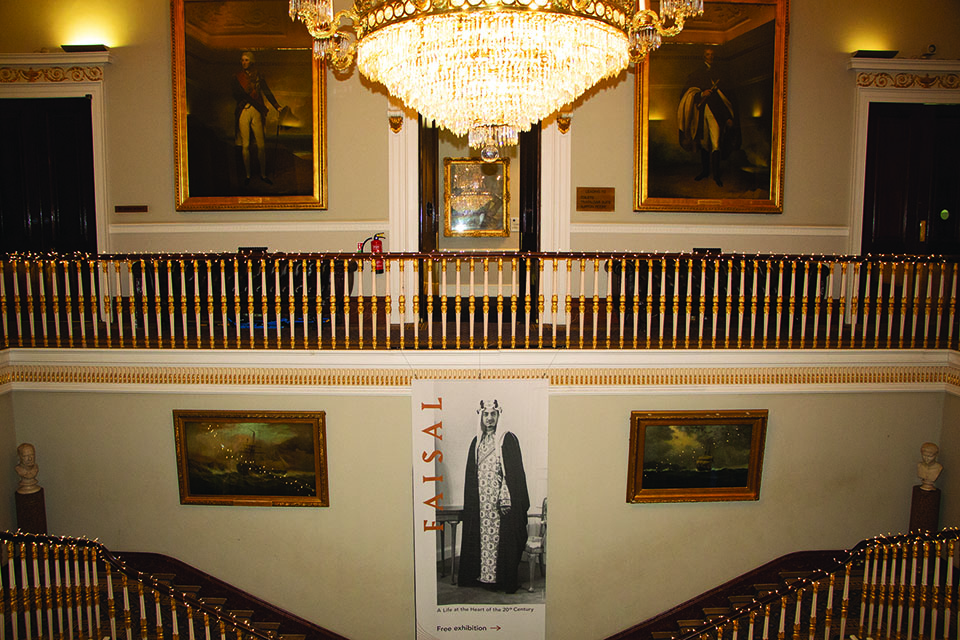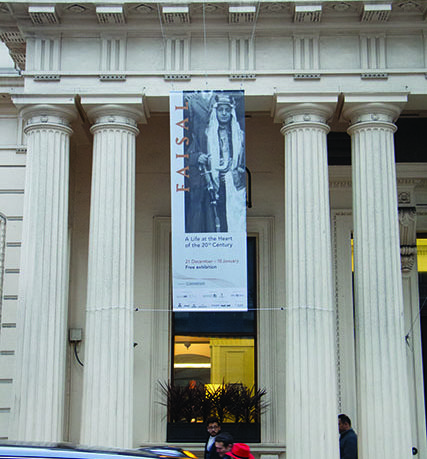Celebrated the Centenary of King Faisal’s Historic Journey to Europe
BY ALEXANDER WOODMAN
“King Faisal was not just a great King in Saudi history, but he became one of the greatest kings and leaders of the world. Remarkably, we repeat his history nowadays, through the transformations, that once were initiated by King Faisal. He led the country despite international pressure, changing times, and regional instability,” said Saudi Ambassador to the United Kingdom, HRH Prince Khaled bin Bandar bin Sultan Al Saud on the occasion of the exhibition “A Life at the Heart of the Twentieth Century”.
The exhibition celebrating the centenary of the life-changing five-month visit of King Faisal Abdul Aziz Al Saud to Britain, Ireland, and France in 1919 was opened on December 20, 2019 in the Nash Room at 116 Pall Mall, London. This historical journey is credited with the start of cordial relations between the Kingdom of Saudi Arabia and the United Kingdom.
Then Prince Faisal, who was only 13 years old, became the first member of the Saudi Royal family to visit England. Later, this trip was considered as one of the most controversial political visits. However, meetings with the world’s influential nations became for young Prince Faisal the first experience on international affairs. Forty-five years passed since this visit before he became the King of Saudi Arabia and one of the most eminent world leaders of the twentieth century.

The exhibition “A Life at the Heart of the Twentieth Century” presented an overview of King Faisal’s visit, with a demonstration of his journey, the places he has visited, and the leaders he has met along the way. The exhibition lasted for three weeks and displayed many of his personal amenities, manuscripts, telegrams, letters, paintings, maps, photographs, and articles. The visitors had an opportunity to observe the press coverage that documented his significant visit to Great Britain. The beginning of this exceptional journey as a future king started with an invitation from King George V to visit London.
“A Life at the Heart of the Twentieth Century” consisted of seven sections, beginning with “Najd,” the story of the early life of Faisal. “India” documented the first overseas visit of the young Prince and his first meeting with those in the outside world. On his way to India, the young Prince stopped at Muscat (Oman) and was hosted by Sultan Taimur bin Faisal.
Later in his life, King Faisal visited India several times. His interest in South Asia and its people grew over the years. And even after Partition, King Faisal maintained strong and deep ties both with India and Pakistan. Remarkably, the Pakistani city of Lyallapur was renamed Faisalabad. On the other hand, King Faisal enjoyed warm friendship with the Prime Minister of India Jawaharlal Nehru, and supported India to participate in the Islamic Summit Conference.
“London” became the first city visited on the groundbreaking trip in 1919. The section on “England, Wales and Ireland” payed tribute to the cities of Britain he visited on his way. “On the battlefields,” focused a spotlight on King Faisal’s visit to the killing fields of Europe, one year after the end of World War I. The “Paris” exhibit commemorated his visit to the French capital and how he met the allies at the Peace Conference in Paris; this section is dedicated to the First World War. “Heritage” concentrated on the discovery of the constructive and prolific outcomes and legacy of his historic trip.
Reflecting on the message and symbolism of “A Life at the Heart of the Twentieth Century” exhibition and centenary journey, His Royal Highness Prince Turki bin Faisal bin Abdulaziz Al Saud, the Chairman of King Faisal Center for Research and Islamic Studies said, “This exhibition shows the start of the career of young Prince Faisal as representative of his father King Abdulaziz throughout his life. Since the first overseas trip of Faisal had been started in England 100 years ago, the place to launch these series of exhibitions was obviously London.”
Further, HRH Prince Turki shared his feelings as a citizen of Saudi Arabia and, as a son of a great leader: “This is very emotional to be both an observer and son of King Faisal. I look back to the origins, and how he paved his path as a king and as a leader. This exhibition brings me back to those days when he enthusiastically and passionately led and developed all segments and resources of the country to make Saudi Arabia a prosperous realm for coming generations.”
During his last state visit to the United Kingdom in 1967, King Faisal was honored by a twenty-one-gun salute and with a Trooping of the Color from the British Army’s Household Cavalry – a significant state honor that is rarely performed to visitors. Queen Elizabeth II met him as a sign of appreciation for his unique dignity and devotion to cordial ties with the United Kingdom.
His Excellency, Ambassador Khaled bin Bandar, encouraged the young population around the world to visit and witness the achievements of Saudi Arabia. “They will gain profound knowledge about this exceptional personality and his character. He was one who created international diplomacy for Saudi Arabia.”
When asked about the traditional values of two Monarchies in the twenty-first century, the Ambassador stated the words of HRH Charles, Prince of Wales: “The mistake people make with tradition, they think that tradition means old. Whereas, tradition means taking what was old and applying something new that will work for you and will coincide with time.”
“A life at the Heart of the Twentieth Century” exhibition has been organized in collaboration with the King Faisal Center for Research and Islamic Studies, King Faisal Foundation, and the Kingdom’s Embassy in the United Kingdom. This exhibition will become one of the series of expositions in Europe to present and introduce King Faisal, his admired character, vision, undying will, and greater contribution to the world.
In 2020, “A Life at the Heart of the Twentieth Century” exhibition will be launched in Paris simultaneously with the Peace Conference.




